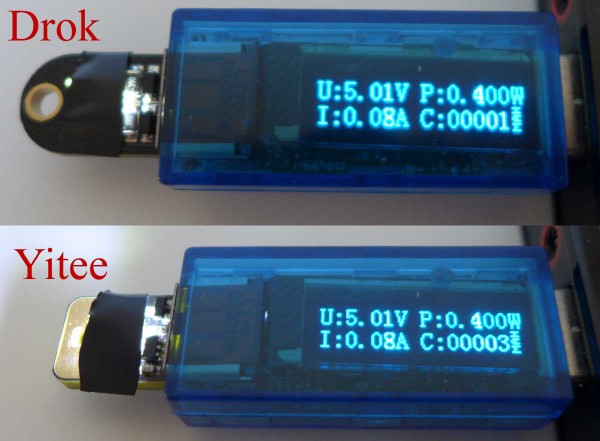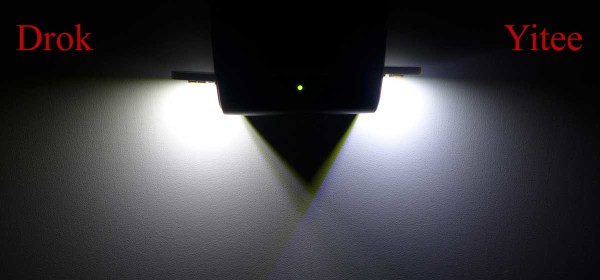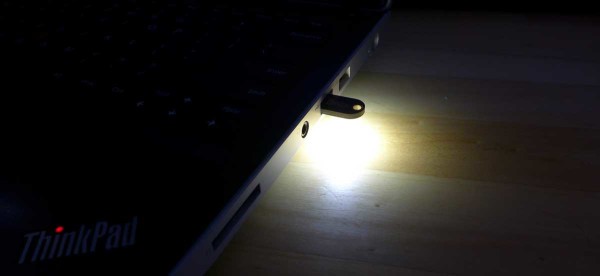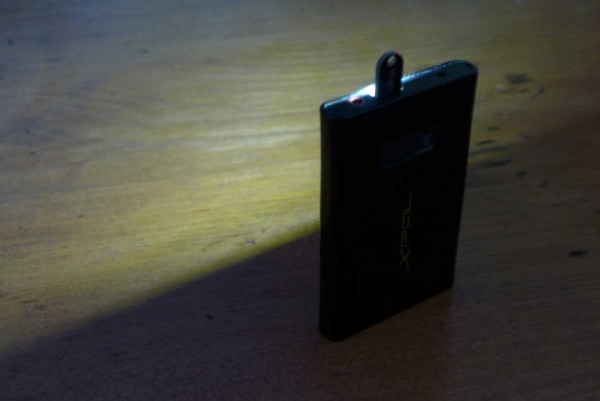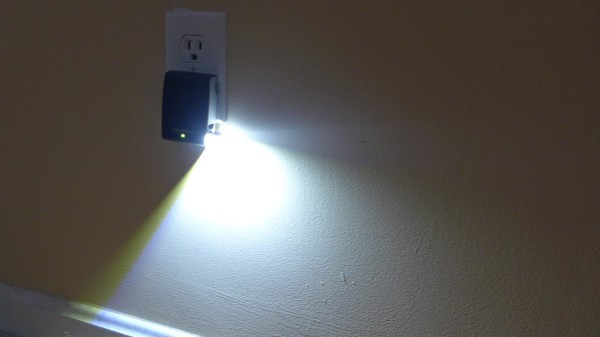“Whoa. What are these?”, I said to myself. And as I looked them over, I realized that what I was holding was essentially just an LED soldered onto a little USB stick. “How useful!”
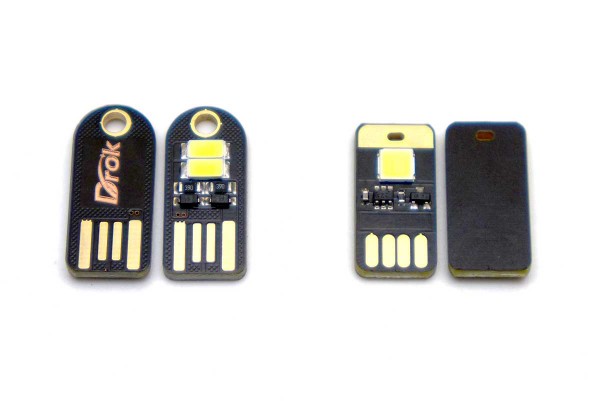 Such a simple concept with such a multitude of purposes.
Such a simple concept with such a multitude of purposes.
- Plug it into the side of your laptop for some additional light.
- Attach one to a portable USB battery pack for an emergency flash light.
- Plug one or two into the side of a USB power outlet for an ad-hoc nightlight.
- Put one on the end of a USB extension cable and snake it into a hard to light spot.
And the nice part is that you can get a 4 or 5 pack of them for less than $10.
Let’s see how they perform!
Overview
This review features 2 mini USB LED sticks from different manufacturers. One from Drok and the other from a company named Yitee.
Drok
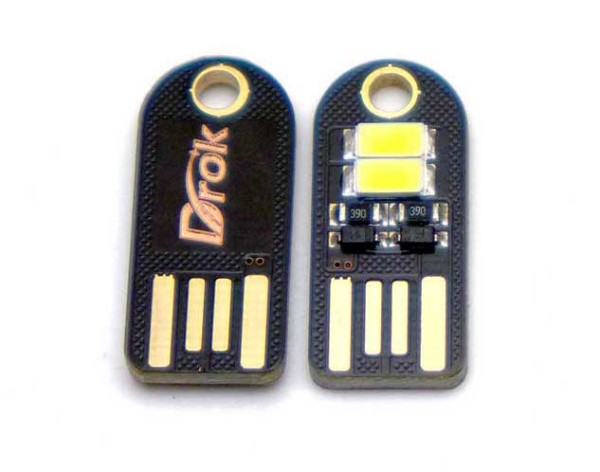 The Drok mini LED USB stick is a 1/2″ wide, 1+” long, and thin enough to fit into a USB port. The PCB contains 2 LEDs and has USB contacts on both the front and the back of the board to allow it to operate in either up or down in the USB port.
The Drok mini LED USB stick is a 1/2″ wide, 1+” long, and thin enough to fit into a USB port. The PCB contains 2 LEDs and has USB contacts on both the front and the back of the board to allow it to operate in either up or down in the USB port.
Yitee
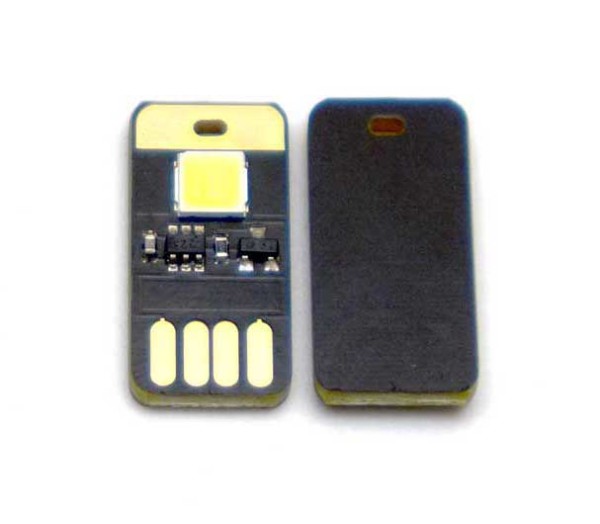 The Yitee mini LED USB stick is similarly 1/2″ wide and thin enough to fit in a USB port and is about 7/8″ long. The PCB contains a single LED and has what appears to be a capacitive touch sensor chip (marked 223) and a transistor on the PCB. This allows the device to be turned on and off merely by tapping the PCB. Unlike the Drok, there are no USB contacts on the back of the PCB, so this can only be operated in one orientation.
The Yitee mini LED USB stick is similarly 1/2″ wide and thin enough to fit in a USB port and is about 7/8″ long. The PCB contains a single LED and has what appears to be a capacitive touch sensor chip (marked 223) and a transistor on the PCB. This allows the device to be turned on and off merely by tapping the PCB. Unlike the Drok, there are no USB contacts on the back of the PCB, so this can only be operated in one orientation.
Performance
Power Use
As shown in the photos here, both devices draw ~80mA @ 5.0v for a computed draw of 0.4 Watts. (A piece of black electrical tape was placed over the LEDs so as not to blind the camera — Both LED sticks are quite bright.)
Light Output
The photo reveals that both LED boards put out a very similar amount of light meaning that they both have similarly efficient LEDs (given that they also draw the same amount of power.)
What’s different about the two is the quality of light that each put out.
As shown in the picture, the DROK (on the left) appears to have a softer and warmer quality to it, while the Yitee (on the right) appears to have a crisper and cooler quality. So what’s going on here?
It turns out that the 2 LEDs on the DROK are actually different. One LED has a warmer color temperature, while the other LED has a cooler color temperature. When both are lit simultaneously, they produce a more natural color spectrum like that of a regular incandescent bulb. This is simple, yet clever engineering.
In contrast, the Yitee only has a single large LED that puts out one type of cool, white light.
Use Cases
As outlined in the beginning of this review, there are a few obvious use cases for these devices.
Laptop
Does this mini LED USB stick help with a laptop in any way?
Somewhat. It shines a bright light down onto your work surface and illuminates the area a little bit. This isn’t particularly helpful, but if you are working in complete darkness, I suppose it helps a bit.
The Drok does help out to a degree. Facing up was not helpful as it blinds the user. Facing down is much better. The Yitee was less helpful because it could only operate in one orientation: facing up. As such, the light is kind of blinding and rather unhelpful.
USB battery pack
How well does the mini LED USB stick work when paired with a USB battery pack?
Quite well, in fact. It isn’t the best flashlight ever, but it lights up an area nicely in the dark. And it only draws 80mA per hour. Most battery packs are 3000+ mAh these days so, theoretically, one of these could run for at least 36 hours straight (or more with a larger battery pack) before fully draining the battery pack. This could be useful for camping trips and power outages!
Both the Drok and the Yitee work reasonably well in this application. Neither hold in the socket super tight, but the friction fit is good on both that they both held fine when we tried to shake them out of their sockets.
The Yitee has the capacitive on/off function which is nice as this doesn’t require the user to remove the light from the USB socket when they’re done.
Nightlight
Do these mini LED USB sticks work well as night lights?
Possibly. With a small USB power outlet, it’s easy to stick one or two of these mini LED USB sticks in and leave them running all the time. They don’t draw a lot of power (3.5 kWh per year when running 24/7/365). So that’s good.
The uncertain part is how well the LEDs will hold up over time running 24/7 — LEDs gradually dim over time and running all the time will cause them to wear out faster, especially if there is no day-light sensor which would otherwise turn them off.
The amount of light put out may also be too bright for some people.
On a USB extension cable
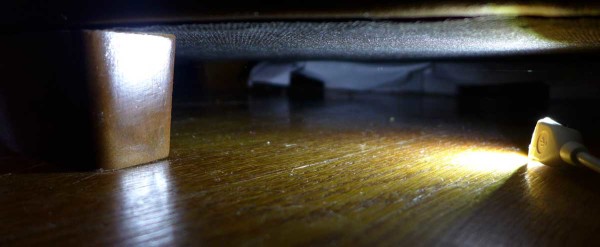
Attach a mini LED USB stick to a USB extension cable and then it can be snaked anywhere that the USB cable can reach. Since the light is only held on by a friction fit, we wrapped some cellophane tape around the light and the cable to hold it in place.
Does it work?
Yes, reasonably well. In absence of a purpose built light designed to snake into narrow spaces, this works pretty well in a pinch. It’s not the best thing ever, but it does work.
Technical Review
| Drok | Yitee | |
| Price | $6.50 | $6.00 |
| Units per pack | 5 | 4 |
| Cost per stick | $1.30 | $1.50 |
| LEDs | 2 | 1 |
| Light color | Warm/soft | Cool/crisp |
| Current | 80mA | 70 – 80mA |
| Reversible | YES | no |
| Touch On/Off | no | YES |
| Keyring hole | YES | YES |
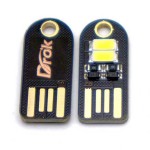 |
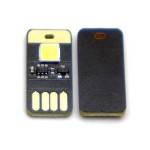 |
Conclusion
Mini LEDs on a USB stick. What a concept!
And yet, the feeling that this was a “solution in search of a problem” was inescapable. Of the 4 possible uses thought up here, neither of the LED USB sticks truly solved any of the problems really well.
Yet, the price was right. $6 for a pack of 4 or 5? Why not?
And that was the conclusion, these little LEDs-on-a-stick are multi-purpose devices that are compact and can be used in a pinch wherever there is a USB port.
